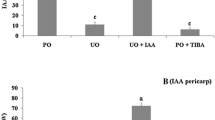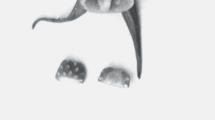Abstract
The development of parthenocarpic fruits of Pisum sativum L. cv. Alaska was induced by the application of different plant-growth regulators in aqueous solution to the emasculated ovaries in untopped plants. At least one compound in each of the groups of auxins (2,4-dichlorophenoxyacetic acid), cytokinins (benzyladenine), and gibberellins (gibberellic acid) was found active. Gibberellic acid (GA3), however, was the only substance which produced pods similar to those of fruits with seeds. The length of the pods obtained by GA3 was a linear function of the logarithm of the concentration of GA3 in the solution. The effect of GA3 (at a concentration which produced 50% of the maximum pod length) was enhanced by a simultaneous application of 2,4-dichlorophenoxyacetic acid. Abscisic acid (ABA) counteracted the effect of GA3 and of topping. The results suggest that gibberellins and ABA may exert a major regulatory control in natural fruit-set. Peas can be used for the assay of fructigenic activity and is an advantageous material for the study of the mode of action of gibberellins on fruit-set.
Similar content being viewed by others
Abbreviations
- ABA:
-
abscisic acid
- 6-BAP:
-
benzyladenine
- 2,4-D:
-
2,4-dichlorophenoxyacetic acid
- GA3 :
-
gibberellic acid
- IAA:
-
indole-3-acetic acid
- NAA:
-
1-naphthaleneacetic acid
References
Bollard, E.G.: The physiology and nutrition of developing fruits. In: Biochemistry of Fruits and their Products, vol. 1, pp. 387–425, Hulme, A.C., ed. London: Academic Press 1970
Carbonell, J., García-Martínez, J.L.: Fruit-set of unpollinated ovaries of Pisum sativum L. Influence of vegetative parts. Planta 147, 444–450 (1980)
Crane, J.C.: Growth substances in fruit setting and development. Annu. Rev. Plant Physiol. 15, 303–326 (1964)
Eeuwens, C.J., Schwabe, W.W.: Seed and pod wall development in Pisum sativum, L. in relation to extracted and applied hormones. J. Exp. Bot. 26, 1–14 (1975)
Gustafson, F.G.: Inducement of fruit development by growthpromoting chemicals. Proc. Natl. Acad. Sci. USA 22, 628–636 (1936)
Gustafson, F.G.: Parthenocarpy: Natural and artificial. Bot. Rev. 8, 599–654 (1942)
Jordan, W.R., Brown, K.W., Thomas, J.C.: Leaf age as a determinant in stomatal control of water loss from cotton during water stress. Plant Physiol. 56, 595–599 (1975)
Larsen, P.: Growth substances in higher plants. In: Modern Methods of Plant Analysis, vol. III, pp. 565–625, Paech, K., Tracey, M.V., eds. Berlin, Göttingen, Heidelberg, Springer 1955
Mainland, C.M., Eck, P.: Endogenous auxin and gibberellin-like activity in highbush blueberry flowers and fruit. J. Am. Soc. Hortic. Sci. 96, 141–145 (1971)
Nitsch, J.P.: Hormonal factors in growth and development. In: Biochemistry of Fruits and their Products, vol. 1, pp. 427–472, Hulme, A.C., ed. London: Academic Press 1970
Sastry, K.K.S., Muir, R.M.: Gibberellin: Effect on diffusible auxin in fruit development. Science 140, 494–495 (1963)
Author information
Authors and Affiliations
Rights and permissions
About this article
Cite this article
García-Martínez, J.L., Carbonell, J. Fruit-set of unpollinated ovaries of Pisum sativum L.. Planta 147, 451–456 (1980). https://doi.org/10.1007/BF00380187
Received:
Accepted:
Issue Date:
DOI: https://doi.org/10.1007/BF00380187




